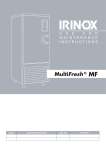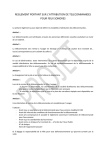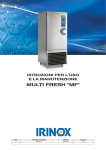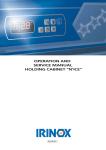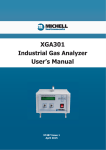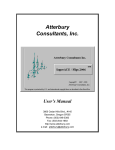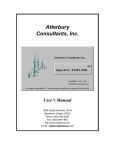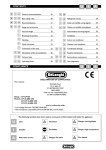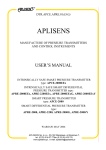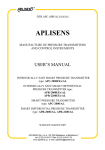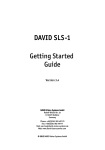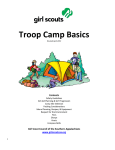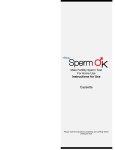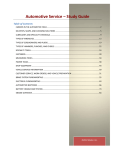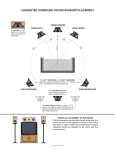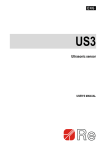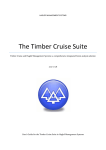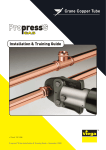Download User Manual
Transcript
USE AND MAINTENANCE INSTRUCTIONS MULTI FRESH "EF" N° REV REVISION DESCRIPTION DATE REV. REVISER Dear Customer, While thanking you for the confidence you have shown us by choosing an IRINOX blast chiller, we invite you to read this manual carefully. It contains all the information you need to start optimal preservation of your products right away. We advise you to study the present manual in order to benefit from all the potentialities and advantages that your IRINOX blast chiller can give you. Correct operation of the machine also depends on its proper use. Keep this manual near the blast chiller so that you and your workers can consult it quickly. Work Well with IRINOX! Subscribe online to Club Irinox : www.irinox.com The graphical representation of the controls in this manual is aimed at making it easier to understand the operations which must be carried out so that you can use your IRINOX blast chiller right away with satisfaction. Symbol key Suggestions and details for correct use of the blast chiller Standards for your safety Added information in the manual Information on the warranty and assistance Warranty validity: for 12 months from the billing date for the individual parts, as carried on the actual price list. Contacts: Customer service: Assistance for use Technical assistance – spare parts Fax E-mail Web site +39.0438.5844 +39.0438.5844 +39.0438.2020 +39.0438.2023 [email protected] www.irinox.com For any request regarding your blast chiller, always specify: • The model • The series number carried on the machine label. INDEX 1. GENERAL DOCUMENTATION 4 1.1 GENERAL WARNINGS 4 1.2 PREAMBLE 4 1.3 TRANSPORT AND HANDLING 4 1.4 UNPACKING 4 1.5 ELEMENTARY SAFETY STANDARDS 5 1.6 PRECAUTIONS FOR LOADING AND UNLOADING THE PRODUCTS 5 1.7 DANGEROUS USE OF THE POINTED PROBE 5 1.8 PERIODICAL PERSONNEL TRAINING 5 2. INSTALLATION 6 2.1 PLATE DATA 6 2.2 POSITIONING 6 2.3 DIMENSIONAL DATA 7 2.4 ROOM TEMPERATURE AND AIR EXCHANGE 9 2.5 REFRIGERATION POWER 9 2.6 ELECTRICAL CONNECTION 9 2.7 REFRIGERATOR CONNECTION 10 2.8 CONDENSATION DRAIN 12 2.9 WATER CONDENSING UNIT CONNECTION 13 2.10 INFORMATION FOR THE INSTALLER 13 2.11 SAFETY AND CONTROL SYSTEMS 14 2.12 R404a GAS SAFETY BOARD 14 2.13 DISPOSAL OF THE MACHINE 15 3. OPERATION 15 3.1 USE 15 3.2 DESCRIPTION OF THE CYCLES 16 3.3 CONTROL PANEL 16 3.4 DESCRIPTION AND OPERATION 17 3.5 STOPPING MODES 22 3.6 ADVICE FOR USE 22 3.7 PARAMETER PROGRAMMING 25 3.8 SANIGEN 27 4. MAINTENANCE / ASSISTANCE 30 4.1 ROUTINE MAINTENANCE 30 4.2 CLEANING THE CELL 30 4.3 CLEANING THE CONDENSER 32 4.4 TROUBLESHOOTING 32 4.5 EXTRAORDINARY MAINTENANCE 34 3 1. GENERAL DOCUMENTATION 1.1. GENERAL WARNINGS • The present manual is an integral part of the product. It supplies all of the necessary conditions for correct installation, use and maintenance of the machine. • The user is obliged to read this manual carefully and to refer to it always. It must be kept in a known place, accessible to all authorised operators (installer, user, maintenance technician). • The blast chiller is intended for professional use. Therefore only qualified personnel can use it. • The blast chiller is destined to be used only for that for which it was designed. • The manufacturer declines all liability for damage caused by improper and unreasonable use, such as: - improper use by untrained personnel. - modifications or interventions not specifically for the model. - use of non-original spare parts or parts not specifically for the model. - lack of compliance, even partial, with the instructions in this manual. 1.2. PREAMBLE Installation must be carried out by authorised and specialised personnel, complying with the instructions in this manual. The manufacturer declares and associates a declaration of conformity to machinery Directive 98/37, to Directive 2006/95 and to Directive 2004/108/CE for each individual machine. If the machine is supplied with a remote condensing unit, the installer will take care to check all of the connections and to leave a declaration that execution was carried out professionally and in compliance with the provisions of the above-mentioned Directive. 1.3. TRANSPORT AND HANDLING • Loading and unloading the appliance from the transportation vehicle can be performed with a forklift truck or pallet mover. The forks must be longer than half the length of the appliance. The lifting device must be chosen suitably, based on the dimensions and mass of the packaged machine, indicated on the packaging labels. All due precautions must be taken to handle the appli- • ance in order not to damage it, respecting the indications on the packaging. 1.4. UNPACKING • Remove the cardboard, wooden or crate packaging upon which the blast chiller is placed. Lift the blast chiller with a suitable means (lift truck), remove the wooden base and position the machine in the intended area (see par. 2.2). • After having removed the packaging, make sure that the blast chiller is intact. • Remove the protective PVC film from all sides (Fig.1). Use protective gloves to handle the packaging and wooden base. N.B.: all of the various packaging components must be disposed of according to the Standards in force in the Country where the appliance is used. In no case must anything be dispersed into the environment. Fig. 1 4 1.5. ELEMENTARY SAFETY STANDARDS • before carrying out cleaning or routine maintenance, disconnect the machine from the power supply network, turning off the master switch and pulling the plug • do not pull the power cord to disconnect the machine from the power supply network. The user is liable for negligence of operations on the machine which do not comply with the instructions in this manual. Hereafter are the general safety Standards: • do not touch the machine with wet or humid hands or feet • do not operate the machine in bare feet • do not insert screwdrivers, kitchen utensils or anything else between the guards and the moving parts 1.6. PRECAUTIONS FOR LOADING AND UNLOADING THE PRODUCTS LOADING • When loading the machine, use kitchen gloves in order to avoid burns due to contact with hot trays and trolleys. UNLOADING • When the blast chilling and/or shock freezing cycles have ended, open the door slowly until the fans stop. • Extract the core probe/s from the product and position it/them on the probe-holder. • Use suitable gloves for cold trays and trolleys. 1.7. DANGEROUS USE OF THE SHARP PROBE Use of the probe is allowed only for personnel who are authorised and trained to use the temperature blast chiller. The core probe must be used only for the purpose for which it was designed: to detect the temperatures at the centre of the food products to be blasted and/or frozen. Handle the probe with care. Its ends are pointed in order to facilitate its insertion in products to be blasted and/or frozen. The ergonomic handle allows correct extraction and insertion. 1.8. PERIODICAL PERSONNEL TRAINING All personnel who are authorised to operate the machine (installer, user, maintenance technician) should be trained periodically on safety Standards. In order to avoid accidents or damage to the equipment, it is also advisable to instruct personnel as to the use and maintenance of the temperature blast chiller, referring to this manual which must be kept near the machine, in a known and accessible spot. IRIN Blas OX Chill t er 5 2. INSTALLATION 2.1. PLATE DATA • Make sure that the plate data and electrical line features correspond (V, kW, Hz, phase and available power). • The plate carrying the features of the appliance is applied on the side (fig.2). 31020 CORBANESE (TV) ITALY Model Series n. mm/yy/progres. Mod. s/n Preparation of machine rooms to dislocate the condensing units must comply with the fire-prevention Standards in force in the Country where the machine is installed (contact the nearest fire station for due indications). V Ph Hz A Compressor Refrigerant Remember also that the potential intervention of safety valves or fuse caps in the refrigeration circuit entails the immediate discharge of all the refrigerant used in the ambient. Therefore make sure to realise opportune means of waste disposal and first aide, as indicated on the safety cards of the refrigerant ( see par. 2.12). Kw Frequency HERMETIC R404 Charge Power Desing pressure (Low) KPa Desing pressure (High) KPa Class Volume Phase Voltage Rated Load IP PED Code Fig. 2 Climatic class: • 4 (30°C room temperature with 55% non-condensing relative humidity) according to Standards CEI EN 60335-1, CEI EN 60335-2-89, ISO 23953-2:2005(E) 2.2. POSITIONING • The blast chiller must be installed and inspected in complete compliance with accident-prevention Law Standards, with traditional rules and with Standards now in force. • The installer must check potential fire-prevention prescriptions (contact the nearest fire station for the due indications). • Place the blast chiller in the intended spot. • Level the appliance by means of the adjustment feet. Use appropriate lifts to level heavier machinery (Fig.3). Fig. 3 • If the appliances are not levelled, their operation and condensation outflow can be jeopardised. To be avoided (Fig.4): • Places exposed to direct sunlight • Closed places with high temperatures and scarce air exchange (see Table 2). • Do not install the machine near to any heat sources. Fig. 4 6 Absorption 2.3. DIMENSIONAL DATA FRONT VIEW SIDE VIEW TOP VIEW EF10.1 EF20.1 EF30.1 EF45.1 7 2.3. DIMENSIONAL DATA EF20.1 condensing unit EF30.1 condensing unit EF45.1 condensing unit P1 L1 P1 L1 P1 L1 H1 H1 H1 Remote condenser Remote condenser P1 P1 H1 H1 Super-silent remote condenser Super-silent remote condenser L1 L1 Remote aircondensing unit Remote aircondensing unit H H P P L L L1 L1 H1 Remote air condenser and remote unit H1 H P1 Remote air condenser and remote unit P1 H P P L L L1 L1 Super-silent remote air condenser and remote unit H1 Super-silent remote air condenser and remote unit P1 H1 H P1 H P P L H L Housed option Housed option H P H L P P L Remote condensing unit dimensions. 8 STD. AIR SUPER SIL AIR. 79 80 84 85 56 67 64 103.5 EF45.1 SUPER SIL AIR. DIM. (cm) L1 P1 H1 Kg EF20.1 EF30.1 STD. AIR MOD. HOUSED REMOTE COND. AIR REMOTE COND. 79 80 79 84 85 84 56 67 64 64 99.5 85 HOUSED AIR 79 84 64 81 AIR MOD. EF45.1 78 78 62 63 37 41 40.5 51 MOD. DIM. (cm) L P H Kg EF30.1 HOUSED EF20.1 STD. AIR Remote condensing unit dimensions. MOD. L 59 27 29 5.6 58 31 51 13 56 60 75 18 59 33 51 21 89 50 60 23 2.4. ROOM TEMPERATURE AND AIR EXCHANGE For the air condensed refrigeration units, operating room temperature must not exceed 32 °C. The declared performances are not guaranteed beyond this temperature. The remote condensing units must be installed in appropriate rooms or outside, in a place sheltered from direct sunlight. If needed, the installer must evaluate using a cover or roof (in any case sufficient air exchange must be assured). Table 2 MINIMUM AIR EXCHANGE MODEL Power supply frequency (Hz) AIR (m3/h) 50 60 50 60 50 60 50 60 1100 1210 3000 3300 3000 3300 EF10.1 EF20.1 EF30.1 EF45.1 For further details, see vedi Table 2. 2.5. REFRIGERATION POWER Table 3 MODEL EF10.1 EF20.1 EF30.1 EF45.1 Power supply frequency (Hz) Refrigeration output (W) 50 60 50 60 50 60 50 60 Condensation power (W) 1727 1623 4105 4746 6013 7216 2683 2549 6375 7717 9075 11038 Declared values at evap. T.=-10°C, cond. T.=+40°C and power supply f.=50Hz. Overheating in compliance with EN12900 2.6. ELECTRICAL CONNECTION Install a differential automatic circuit-breaker switch upstream every appliance, according to the Standards in force in the Country of installation. The power supply must be brought to the blast chiller electrical control board, according to the data carried on Table 4. • The electrical power supply cables must have the correct size and be chosen depending on the real laying conditions; • The electrical cables must enter and be blocked in the appropriate cable sleeve and laid adequately depending on the installation ambient; • Each conductor must be inserted in the corresponding terminal; • The earth conductor must be connected directly to an effective earthing system. Fig. 5 The manufacturing company declines all liability and warranty obligations if persons are harmed or appliances and objects damaged, due to incorrect installation and/or lack of compliance with laws in force. Fig. 6 If the power supply cable is damaged, it must be replaced by the manufacturer or by the technical assistance service or anyhow by a person with a similar qualification, in order to avoid every risk!!! 9 Table 4 MODEL EF10.1 TYPE OF CONDENSING UNIT Voltage (V) Frequency (Hz) Air Air EF20.1 POWER SUPPLY REMOTE CONDENSING CABLE SECTION UNITS CABLES SECTION Power (kW) Current (A) *1 *2 POWER SUPPLY Remote air condenser Water Air Remote air condenser EF30.1 Remote super-silent air condenser Water Air Remote air condenser EF45.1 Remote super-silent air condenser Water ABSORPTION Poles 230 230 50 50 1P+N+PE 1P+N+PE 230 60 230 230 230 230 400 400 230 230 400 400 230 230 400 400 230 230 400 400 230 230 400 400 230 230 400 400 230 230 400 400 230 230 400 400 230 230 5 6,3 1P+N+PE 1125 1,2 1,3 50 1P+N+PE 1,3 6,7 60 50 60 50 60 50 60 50 60 50 60 50 60 50 60 1P+N+PE 1P+N+PE 1P+N+PE 3P+N+PE 3P+N+PE 3P+PE 3P+PE 3P+N+PE 3P+N+PE 3P+PE 3P+PE 3P+N+PE 3P+N+PE 3P+PE 3P+PE 3P+N+PE 3P+N+PE 3P+PE 3P+PE 3P+N+PE 3P+N+PE 3P+PE 3P+PE 3P+N+PE 3P+N+PE 3P+PE 3P+PE 3P+N+PE 3P+N+PE 3P+PE 3P+PE 3P+N+PE 3P+N+PE 1,4 1,2 1,2 2,9 3,5 3,0 3,7 2,9 3,6 3,0 3,7 2,9 3,5 3,0 6,5 5,9 5,8 5,2 5,2 12,2 12,5 5,4 5,3 12,4 12,7 5,3 5,2 50 60 50 60 50 60 50 60 50 60 50 60 50 60 50 60 50 60 50 60 3P+PE 3P+PE 3,6 2,8 3,4 2,9 3,5 3,7 3,9 3,8 4,7 3,8 3,9 3,9 4,8 3,8 3,9 3,9 4,8 3,6 3,8 3,8 4,6 3G1,5mmq 3x1,5mmq + 3G2,5mmq 3G1,5mmq 3x1,5mmq + 3G2,5mmq 5G1,5mmq 10x1,5mmq + 4G1,5mmq 4G1,5mmq 10x1,5mmq + 4G2,5mmq 10x1,5mmq + 4G4mmq 5G1,5mmq 10x1,5mmq + 4G1,5mmq 4G1,5mmq 10x1,5mmq + 4G2,5mmq 10x1,5mmq + 4G4mmq 5G1,5mmq 10x1,5mmq + 4G1,5mmq 4G1,5mmq 10x1,5mmq + 4G2,5mmq 10x1,5mmq + 4G4mmq 5G1,5mmq 10x1,5mmq + 4G1,5mmq 4G1,5mmq 10x1,5mmq + 4G2,5mmq 10x1,5mmq + 4G4mmq 5G1,5mmq 10x1,5mmq + 4G1,5mmq 4G1,5mmq 10x1,5mmq + 4G4mmq 5G1,5mmq 10x1,5mmq + 4G1,5mmq 4G1,5mmq 10x1,5mmq + 4G4mmq 5G1,5mmq 10x1,5mmq + 4G1,5mmq 4G1,5mmq 10x1,5mmq + 4G4mmq 5G1,5mmq 10x1,5mmq + 4G1,5mmq 4G1,5mmq 10x1,5mmq + 4G4mmq 6,2 12,3 12,5 5,2 5,1 12,2 12,3 5,6 6,0 14,1 14,7 5,7 6,1 14,4 14,9 5,7 6,1 14,4 14,9 5,5 5,9 14,1 14,5 2.7. REFRIGERATION CONNECTION 2.7.1. Equal level installation General criteria for installation of remote units: 1) Sloping of the ducts (Fig.7). 2% CO MP 2) Bracket clamping on insulated tubes (Fig.8). RE SS Fig. 7 3) Hermetic sealing (Fig.9). 4) Vacuum execution (0.03mBar) in connection ducts (delivery and intake). Condensing unit and Freon loading, if not indicated differently. Fig. 8 10 OR 5) Checking vacuum sealing of the ducts. 6) Opening of interception taps on condensing unit. 7) Leakage check. Fig. 9 8) Checking exact gas loading by means of liquid passage indicator light placed on condensing unit. Equal level installation 9) Checking of condensation water circulation and pressure (water condensation systems). The criteria indicated above is sufficient for equal level installation (Fig.10) Fig. 10 2.7.2. Different level installation If the remote unit is installed higher up than the appliance (fig.12), a siphon must be installed at each start or ascent (a), every 1.8 metres of difference in level along the return duct, and at each arrival (b). Different level installation If the remote unit is installed lower than the appliance, no siphon is needed (fig. 11). Fig. 11 11 Fig. 12 2.7.3. Refrigerator - remote units connection The diameters of the supply ducts of the equipment are dimensioned for installation distances up to 25 metres (see Table 5). For greater distances, contact IRINOX SpA. Insulation of the intake and hot gas line must be done with a good quality closed-cell insulation, at least 19 mm thick. 19 mm Table 5 REMOTE UNIT MODEL REMOTE CONDENSER WATER UNIT REMOTE CONDENSER AND STANDARD OR S.SILENT REMOTE CONDENSER ø IN cond. ø OUT cond. ø IN cond. ø OUT cond. ø Liquid ø Intake mm mm mm mm mm mm mm 8 10 8 8 / / / / 10 16 12 10 12 10 10 16 ø Liquid ø Liquid mm ø IN water ø OUT water EF10.1 EF20.1 EF30.1 FE 3/4" FE 3/4" EF45.1 2.7.4 R404a pressure switch calibration For calibration of the R404a pressure switches see Table 6 Table 6 AIR CONDENSATION WATER CONDENSATION HIGH P. FAN START SAFETY VALVE HIGH P. SAFETY VALVE (Bar) (Bar) (Bar) (Bar) (Bar) EF10.1 EF20.1 25 / 17(*1) / / / EF30.1 27.6 17(*1) 29.5 25 28.5 MODEL EF45.1 17(*1) *1: Only when the condensing unit or the condenser is remote. 2.8. CONDENSATION DRAIN The blast chillers are equipped with a small tray to gather condensation. The tray can put extracted from the bottom part of the Blast chiller. 12 2.9. WATER CONDENSING UNIT CONNECTION • During inspection of the water network, with the machine stopped and the water mains ready, check that the drain tube of the condenser does not leak water. If it does, adjust the pressure switch valve until leaking stops (Fig.13). • It is recommended to install a water gate and an inspection filter on the water delivery line. The delivery and drain tube of the condenser are indicated by the appropriate plates. Both connections are 3/4”F threaded. • See Table 7 for maximum water consumption. FEATURES OF THE LINE FOR WATER CONDENSING UNITS Maximum pressure of inlet water 1600 KPa Minimum pressure of inlet water 50 KPa Maximum temperature of inlet water to guarantee normal operation of the appliance 25°C (well water) 40°C (tower water) Fig. 13 Table 7 MAXIMUM WATER CONSUMPTION MODEL EF20.1 EF30.1 EF45.1 Power supply frequency (Hz) 50 60 50 60 50 60 WATER l/h m3/h 128 103 248 312 345 435 0,13 0,1 0,25 0,31 0,35 0,43 Values referring to an inlet water temperature = 15°C Maximum inlet water temperature = 22°C Maximum inlet water pressure to condenser = 1600kPa Minimum inlet water pressure = 150KPa 2.10. INFORMATION FOR THE INSTALLER Checking a correct installation and inspection: • Check for gas leaking from seals or joints made during installation. • Check that the connection tubes between the conserver and the remote condensing unit are well insulated. • Check the electrical connections. • Check the absorptions. • Check the standard pressures. • Check the water connection with the adjustment of the pressure switch valve during operation and that condensation water circulates well. Inform the customer on the exact use of the equipment, with specific reference to the use and needs of the customer. Installation and commissioning must be carried out by authorised personnel. 13 2.11. SAFETY AND CONTROL SYSTEMS • Door micro switch (A): blocks the fans when the door is opened. • Protection fuses (B): protects circuits from short-tcircuits and overloads. • Fuse holders (C): contain the fuses and allow circuit opening and disconnection. • Circuit boards (D): depending on the parameters acquired, they command and control the various blast chiller devices connected to them. • Cell temperature control (E): managed by a circuit board by means of a PT1000 probe. • Safety pressure switch (F): intervenes when there is too much pressure in the refrigerating circuit. • Safety valve (G): intervenes when there is too much pressure in the system and when the safety pressure switch does not intervene. The intervention discharges excess gas from the ambient. Fig.A Fig.B Fig.C Fig.D Fig.E Fig.F Fig.G Fig. 14 2.12. R404A GAS SAFETY BOARD • Identification of dangers Elevated inhalation exposure can have anaesthetic effects. Very high exposure can cause cardiac rhythm anomalies and cause sudden death. The nebulised or squirted product can cause frost burns to the eyes or skin. Dangerous for the ozone layer. Swallowing Do not provoke vomiting. If the injured person is conscious, have the mouth rinsed with water and have him/her drink 200-300 ml of water. Seek immediate medical assistance. Further medical care Symptom treatment and support therapy when indicated. Do not administer adrenalin or similar sympathomimetic drugs after exposure, due to the risk of cardiac arrhythmia with possible cardiac arrest. • First aide measures Inhalation Move the injured person away from exposure and keep him/her warm and at rest. Give oxygen if needed. Perform artificial respiration if breathing has stopped or gives signs of stopping. In case of cardiac arrest, perform an external heart massage. Seek immediate medical assistance. • Fire-prevention measures Non flammable. Thermal decomposition causes the emission of toxic and corrosive vapours (hydrogen chloride, hydrogen fluoride). In case of fire, use a self-contained breathing apparatus and suitable protective clothing. Skin contact Have the concerned areas thaw with water. Remove contaminated clothing. Attention: clothing can stick to the skin for frost burns. For skin contact, wash immediately and abundantly with lukewarm water. If symptoms occur (irritation or formation of blisters) seek medical assistance. Fire extinguishers Use extinguishing agents appropriate for the surrounding fire. • Toxicological information Inhalation More elevated atmospheric concentrations can cause anaesthetic effects with possible losing of conscience. Very high exposure can cause cardiac rhythm anomalies and cause sudden death. More elevated concentrations can cause asphyxiation due to the reduced content of oxygen in the air. Eye contact Wash immediately with an eye-wash solution or with clean water, keeping the eyelids aside, for at least 10 minutes. Seek medical assistance. 14 2.12. R404A GAS SAFETY BOARD • Measures to be taken in case of accidental leaking Make sure to have adequate personal protection when eliminating leakage (using protective devices for the respiratory tract). If the conditions are safe enough, insulate the source of the leakage. If leakage is moderate, let the material evaporate as long as there is adequate ventilation. Considerable leakage: -ventilate the area; -restrain the poured material with sand, earth or another suitable absorbing material; -prevent the liquid from penetrating drains, sewer systems, basements or work holes, since the vapours can create a suffocating atmosphere. Skin contact Liquid squirts and nebulised liquid can cause frost burns. It is improbable that it is dangerous for skin absorption. Repeated and prolonged contact can cause removal of skin fat, with consequential drying, chapping and dermatitis. • Ecological information It decomposes relatively quickly in the lower atmosphere (troposphere). The decomposition products are highly dispersed and therefore have a very low concentration. It does not affect photochemical smog (this means it is not included among the volatile organic compounds VOC- according to the UNECE agreement). The ozone destruction potential (ODP) is 0.055 measured by a standard ODP equal to 1 for CFC-11 (according the UNEP definitions). The substance is regulated by the Protocol of Montreal (1992 revision). The discharge of the product released in the atmosphere does not contaminate waters on a long term. • Handling Avoid inhaling high concentrations of vapours. Atmospheric concentrations must be reduced to a minimum and maintained at the minimum level reasonably possible, below the professional exposure limit. The vapours are heavier than air. Therefore high concentrations can be formed near the ground where general ventilation is scarce. In these cases, assure adequate ventilation or wear suitable protective devices for the respiratory tract with an air tank. Avoid contact with open flames and hot surfaces because irritating and toxic decomposition products can be formed. Avoid contact between liquid and eyes or skin. • Considerations regarding disposal The best solution is to recover the product and have it recycled. If this is not possible, destruction must be carried out in an authorised plant equipped to absorb and neutralise the acid gases and other toxic products. 2.13. DISPOSAL OF THE MACHINE The demolition and disposal of the machine must be carried out in compliance with the Standards in force in the Country of installation, above all concerning refrigerating gas and lubrication oil of the compressor. The symbol of the barred bin carried on the appliance or on its packaging indicates that the product must be disposed of separately from other waste at the end of its life. Differentiated waste collection of the appliance at the end of its life is organised and managed by the manufacturer. The user who wants to free himself of this appliance must therefore contact the manufacturer and follow the system that has been adopted to allow separate waste collection of the equipment at the end of its life. Adequate differentiated waste collection sending the appliance on to recycling, treatment or environmentally compatible waste disposal contributes to avoid negative effects for the environment and for health and promotes the reuse and/or recycling of the materials the appliance is composed of. Illegal waste disposal of the product by the user entails the application of administrative sanctions foreseen by the Standards. INFORMATION FOR USERS In compliance with Directives 2002/95/CE, 2002/96/CE and 2003/108/CE, relative to the reduction of use of dangerous substances in electrical and electronic appliances, as well as their waste disposal. In compliance with Directives 2002/95/CE, 2002/96/CE and 2003/108/CE, relative to the reduction of use of dangerous substances in electrical and electronic appliances, as well as their waste disposal. 3. OPERATION 3.1. USE The temperature blast chillers have been designed to blast the temperature of just-cooked food, in order to preserve them longer, maintaining their organoleptic characteristics unchanged. The Easy Fresh series has been studied to make this operation as easy as possible: few buttons, clear and essential information for users who approach this new system; the possibility of customising for more expert users. The EF series can perform 4 types of blasting: • DELICATE CHILLING • STRONG CHILLING • DELICATE FREEZING • STRONG FREEZING 15 3.2. DESCRIPTION OF THE CYCLES DELICATE CHILLING cycle: With this cycle, food temperature falls rapidly until +3°C at the core, with an operation temperature between 0°C and +2°C. This cycle is particularly indicated for delicate products like: Mousse, Puddings and other spoon desserts, Creams, Desserts, Vegetables, Less thick foods DELICATE FREEZING cycle: This cycle has two shock freezing phases. In the first phase, the temperature at the core of the product is brought to +6°C, with an operation temperature of 0°C. In the second phase, the core temperature of the product is brought to -18°C, with an operation temperature that can reach -40°C. This cycle is particularly indicated for shock freezing: - baked items STRONG FREEZING cycle: With this cycle, the temperature of the product falls rapidly until -18°C at the core, with an operation temperature that can reach -40°C. This cycle is particularly indicated for shock freezing of foods. STRONG CHILLING cycle: With this cycle, food temperature falls rapidly until +3°C at the core, with an operation temperature between -15°C and +2°C. This cycle allows reducing work times considerably. It is particularly indicated for products: With a high fat content, Very dense, Big pieces, Wrapped 3.3. CONTROL PANEL DL1 DL3 P3 DL5 P6 DL8 DS1 P1 DL2 DL9 DL4 P4 P2 DS1: Cell temperature display / parameter value DS2: Core probe temperature display / cycle time / parameter DL1: DELICATE CHILLING cycle LED DL2: STRONG CHILLING cycle LED DL3: DELICATE FREEZING cycle LED DL4: STRONG FREEZING cycle LED DL5: Cycle start LED DL8: Data printing activation LED DL9: DEFROST cycle LED P1: P2: P3: P4: P5: P6: P7: P8: P9: P8 DELICATE CHILLING cycle selection key STRONG CHILLING cycle selection key DELICATE FREEZING cycle selection key STRONG FREEZING cycle selection key Cycle Start/Stop key Data increase key Data decrease key Registered data download key DEFROST cycle selection key 16 DS2 P5 P7 P9 3.4. DESCRIPTION AND OPERATION LED description Off On Flashing DL1 DELICATE CHILLING cycle not selected DELICATE CHILLING cycle selected Cycle selection standby DL2 STRONG CHILLING cycle not selected STRONG CHILLING cycle not selected Cycle selection standby DL3 DELICATE FREEZING cycle not selected DELICATE FREEZING cycle Cycle selection standby selected DL4 STRONG FREEZING cycle not selected STRONG FREEZING cycle selected Cycle selection standby DL5 No cycle active Cycle in progress Cycle start standby / User parameter programming DL8 Data download not in progress Data download in progress NOT INCLUDED DL9 DEFROST cycle not selected DEFROST cycle in progress NOT INCLUDED Preliminary Operations Phase Front panel screen Description FIRST TURN ON To be carried out after a long period in which the blast chillier has been without power 1 Power the blast chiller and leave it at “OFF” for about 60 minutes. This way the sump resistance will have time to heat the compressor. This avoids breakdown at the first turn-on, due to returning refrigerant liquid. CHAMBER PRE-COOLING Before introducing the product in the chamber, it is recommended to carry out pre-cooling. 1 Start the chosen cycle for at least minutes before putting the hot food into the blast chiller 17 Blast chiller cycle selection and start-up Phase Description Front panel screen 1 When the blast chiller is powered, on the display appears: • Internal chamber temperature • Blast chiller "OFF" status 2 The DL1, DL2, DL3, DL4 LEDs flash waiting for selection of the cycle 3 Select the cycle pressing: • P1 for the DELICATE CHILLING cycle • P2 for the STRONG CHILLING cycle • P3 for the DELICATE FREEZING cycle • P4 for the STRONG FREEZING cycle The LED of the selected cycle turns on, while the others turn off. The DL5 LED starts to flash 4 If the wrong cycle is selected press the key of the correct cycle The cycle LED which was previously selected will turn off. The selected cycle LED will turn on 5 Press P5 The DL5 LED to start the selected cycle. turns on The P1 , P2 , P3 keys are disabled. , P4 , P9 The cycle changes automatically depending on whether the Core probe is inserted or not. Core probe inserted: • the AUTOMATIC mode starts: chill blasting logic in based on the internal temperature of the product Core probe NOT inserted: • the MANUAL mode starts: the chill basting logic is based on a set time AUTOMATIC MODE 6A Insert the Core probe into the product 7A Close the door of the blast chiller 8A The cycle starts On DS1 the cell temperature is displayed On DS2 the product temperature is displayed 18 Phase 9A Description Front panel screen Pressing P6 and P7 on DS2 the time gone since the start of the cycle is displayed. This function can be used at the end of the cycle to determine the time needed for blast chilling of a typical product. That time can be used thereafter to blast chill a similar product using MANUAL mode. 10A When the Core probe reaches the temperature programmed for the chosen cycle (set value), the cycle ends. A signal goes off for 5 seconds, DS1 and DS2 flash. 11A A product preservation cycle starts. ATTENTION! Do not use the Blast chiller as a Conserver. 12A Press P5 to interrupt preservation. The Blast chiller goes back to “OFF”. 13A Open the door of the Blast chiller, extract the Core probe and place it back into its housing. Take the trays out with the blast chilled food and put them back into a Conserver. MANUAL MODE 6M Do NOT insert the Core probe into the product 7M Close the door of the Blast chiller 8M The cycle starts. On DS1 the cell temperature is displayed. On DS2 the duration of the blast chilling cycle is displayed in h:mm, where “h” represents the hours and “mm” the minutes left until the end of the cycle. 9M Press P6 or P7 to increase or decrease the time displayed on DS2. The time is memorised 3s after the pressing of the last button. 19 Phase Description Front panel screen 10M When the set time is reached, the cycle ends. An acoustic signal goes off for 5 seconds. DS1 and DS2 flash. 11M A product preservation cycle starts ATTENTION! Do not use the Blast chiller as a Conserver. 12M Press P5 to interrupt preservation. The Blast chiller goes back to “OFF”. 13M Open the door of the Blast chiller, take the trays out with the blast chilled food and put them back in a Conserver. Defrost cycle selection and start-up Phase Description Front panel screen 1 The display shows: • Internal chamber temperature • Blast chiller "OFF" status 2 The DL1, DL2, DL3, DL4 LEDs flash waiting for selection of the cycle 3 Press P9 4 The DL5 LED 5 Open the door of the Blast chiller 6 Press P5 to select the DEFROST cycle flashes The DL5 and DL9 LEDS turn on On DS1 the cell temperature is displayed On DS2 the duration of the defrost cycle is displayed in h:mm, where “h” represents the hours and “mm” the minutes left until the end of the cycle. 7 Press P6 or P7 to increase or decrease the time displayed on DS2. The time is memorised 3s after the pressing of the last button. 8 If the door closes during the DEFROST cycle: • The cycle is suspended • The remaining time counter blocks • An acoustic signal goes off • The “door” symbol flashes 20 Defrost cycle selection and start-up Phase Description Front panel screen 9 When the set time is reached, the cycle ends. An acoustic signal goes off for 5 seconds. DS1 and DS2 flash. 10 Press P5 . The Blast chiller goes back to “OFF” Data printing selection and start-up Function Description 0 Connect the portable printer or the USB Memory Key to the 9 pole serial socket. The socket is mounted on the front part of the electrical control board. 1 The display shows: • Internal chamber temperature • Blast chiller "OFF" status 2 The DL1, DL2, DL3, DL4 LEDs flash waiting for selection of the cycle 3 Press P8 to select printing / download of registered data 4 The DL8 LED turns on On DS1 the cell temperature is displayed On DS2 “Pri” is displayed 5 When data download is complete, the Blast chiller goes back to “OFF” Front panel screen Registration memory reset 6 with the Blast chiller “OFF” press P8 and P9 simultaneously; the DL8 and DL9 LEDs will flash 21 3.5. STOPPING MODES To turn the machine off in case of an emergency, press START/STOP P5 board (Fig.15). and cut power from the main Fig. 15 3.6. ADVICE FOR USE Before starting the machine, the inside of the cell must be cleaned well ( see par. 4.2). 3.6.1. Loading products Do not cover the trays and containers with lids or plastic wrap: the greater the food surface exposed to cold air, the less time will be needed for blast chilling. It is recommended to use trays and containers as shallow as possible, and anyhow not more than 6.5 cm deep. For better results, load the containers with a product weighing 3.5 kg and with a maximum thickness of 8 cm for blast chilling, or 5 cm for shock freezing. For difficult products and/or fats, reduce thickness even more. Make sure to leave enough space between the trays so that air can circulate adequately. 0,5-2 cm 22 If the machine is not loaded completely, concentrate the trays in the middle of the blast chiller, placing an empty tray (A) above the last one. A Position the trays in the innermost part of the tray-holder, making sure that they are as close as possible to the evaporator. Do not overload the machine beyond what the manufacturer has established (Tab. “Tray yield and capacity”). MODELS Yield Tray capacity Blast chilling (Kg) Shock freezing (Kg) EF5-1 20 15 30 30 EF10-1 45 45 EF15-1 The yield is stated at the following conditions: - Trays filled with water at 90°C - Room temperature: 32°C - No chamber pre-cooling 3.6.2. Pre-cooling Before a cycle of blast chilling and/or shock freezing, it is essential to pre-cool the chamber in order to further reduce work time. Therefore, before inserting the product to be blast chilled, carry out an empty SOFT or HARD cycle. Do not leave the hot product inside of the chamber, in order to avoid damaging the machine. As soon as the product to be treated is inserted, start the blast chilling or shock freezing cycle right away. 3.6.3. Core probe The core probe must be positioned correctly at the centre of the largest piece or cut of the product. Make sure that the point of the probe does not come out of the product or touch the tray. The probe must be cleaned and sanitised before each work cycle in order to avoid unwanted contamination. For better results, load the GN1/1 containers with a product weighing 3.5 kg and with a maximum thickness of 8 cm for blast chilling, or 5 cm for shock freezing. For difficult products and/or fats, reduce thickness even more. 23 N° GN 5 10 15 1/1 1/1 1/1 3.6.4. Temperatures Avoiding having the cooked food to be blast chilled and/or shock frozen remain for long at room temperature. The more moisture is lost, the less food softness will be preserved. Start the blast chilling and/or shock freezing cycle as soon as preparation and/or cooking has ended. Make sure to put the food inside the blast chiller at a temperature that is not below +70°C. Cooked food can enter into the blast chiller even at very high temperatures (>100°C), as long as the chamber is pre-cooled. Remember however that reference times for the cycles start at +90°C (from +90°C to +3°C or the blast chilling cycle; from +90°C to -18°C for the shock freezing cycle). 60 50 40 OK!! 30 20 10 NO!! 3.6.5. Preservation Blast chilled and/or shock frozen food must be properly covered and protected (with plastic wrap, a hermetic lid or, even better, vacuum-packed) and marked with an adhesive label upon which the content, day of preparation and the assigned expiration date are carried, with indelible writing. The blast chilled food must be preserved in a refrigerated cabinet at a constant temperature of +2°C. CONTENT Preparation data The shock frozen food must be preserved in a freezer cabinet at a constant temperature of -20°C. Expiration date Do not use the blast chiller as a normal refrigerator! 24 3.7. PARAMETER PROGRAMMING Parameter programming Parameter programming is accessed with the blast chiller “OFF”. Press the P5 button for 5s. • The DL5 LED will flash • The DS1 display shows “PrC” • The DS2 display shows “----” Press P6 or P7 to select: 1. “PrC”: Cycle parameters 2. “PrC”: Operator parameters Press P5 to confirm the selection. Key use for parameter navigation: - P5 key : confirms the value selected and passage to the successive value - P6 key : increases the value of the selected parameter - P7 key : decreases the value of the selected parameter After the final parameter, programming is exited automatically 60s after the last key was pressed, the programming phase is exited automatically PrC - CYCLE parameters: DELICATE CHILLING cycle Press P1 The DS1 displays shows the set N. The DS2 display shows the parameter value set n. Description Range Resolution 1-A Blast chilling air temp. - S1 -50 ÷ +40°C 1°C -1°C 2-A Preservation air temp. - S1 -50 ÷ +40°C 1°C +2°C 3-A Cycle end core temp. - S2 -50 ÷ +40°C 1°C +3°C 1-M Blast chilling air temp. - S1 -50 ÷ +40°C 1°C -1°C 2-M Blast chilling air temp. - S1 -50 ÷ +40°C 1°C +2°C 3-M Blast chilling phase duration 1min ÷ 3h 1min / 1h 1:30 min A = AUTOMATIC mode Default values M= MANUAL mode STRONG CHILLING cycle Press P1 The DS1 displays shows the set N. The DS2 display shows the parameter value set n. Description Range Resolution Default values 1-A Blast chilling air temp. PHASE 1 - S1 -50 ÷ +40°C 1°C -20°C 2-A Blast chilling air temp. PHASE 2 - S1 -50 ÷ +40°C 1°C -1°C 3-A Cycle end core temp.- S2 -50 ÷ +40°C 1°C +20°C 4-A Cycle end core temp.- S2 -50 ÷ +40°C 1°C +3°C 5-A Preservation air temp. - S1 -50 ÷ +40°C 1°C -+2°C 1-M Blast chilling air temp. PHASE 1 - S1 -50 ÷ +40°C 1°C -20°C 2-M Blast chilling air temp. PHASE 2 - S1 -50 ÷ +40°C 1°C -1°C 3-M Preservation air temp. - S1 -50 ÷ +40°C 1°C +2°C 4-M Blast chilling duration PHASE 1 1min ÷ 3h 1min / 1h 30 min 5-M Blast chilling duration PHASE 2 1min ÷ 3h 1min / 1h 60 min A = AUTOMATIC mode M= MANUAL mode 25 DELICATE FREEZING cycle Press P3 The DS1 displays shows the set N. The DS2 display shows the parameter value set n. Description Range Resolution Default values 1-A Shock freezing air temp. PHASE 1 - S1 -50 ÷ +40°C 1°C 0°C 2-A Shock freezing air temp. PHASE 2 - S1 -50 ÷ +40°C 1°C -40°C 3-A Preservation air temp. - S1 -50 ÷ +40°C 1°C -19°C 4-A Shock freezing cycle core temp. PHASE 1 - S2 -50 ÷ +40°C 1°C +6°C 5-A Cycle end core temp.- S2 -50 ÷ +40°C 1°C -18°C 1-M Shock freezing air temp. PHASE 1 - S1 -50 ÷ +40°C 1°C 0°C 2-M Shock freezing air temp. PHASE 2 - S1 -50 ÷ +40°C 1°C -40°C 3-M Preservation air temp. - S1 -50 ÷ +40°C 1°C -19°C 4-M Blast chilling duration PHASE 2 1min ÷ 8h 1min / 1h 1h 5-M Blast chilling duration PHASE 1 1min ÷ 8h 1min / 1h 3h A = AUTOMATIC mode M = MANUAL mode STRONG FREEZING cycle Press P4 The DS1 displays shows the set N. The DS2 display shows the parameter value set n. Description Range Resolution Default values 1-A Shock freezing air temp. - S1 -50 ÷ +40°C 1°C -40°C 2-A Preservation air temp. - S1 -50 ÷ +40°C 1°C -19°C 3-A Cycle end core temp.- S2 -50 ÷ +40°C 1°C -18°C 1-M Shock freezing air temp. - S1 -50 ÷ +40°C 1°C -40°C 2-M Preservation air temp. - S1 -50 ÷ +40°C 1°C -19°C 3-M Shock freezing phase duration 1min ÷ 8h 1min / 1h 4h A = AUTOMATIC mode M = MANUAL mode DEFROST cycle Press P7 The DS1 displays shows the set N. The DS2 display shows the parameter value set n. Description Range Resolution Default values 1 Shock defrosting phase duration 1min ÷ 2h 1min / 1h 30 min OPERATOR pro - parameters: The DS1 displays shows the set N. set n. The DS2 display shows the parameter value Range Default values Description 1-o 1÷7 1 Day of the week setting 2-o 1 ÷ 12 1 Month setting 08 Year setting 4-o 1 ÷ 23 0 Hour setting 5-o 1 ÷ 59 0 Minute setting 6-o 0÷1 0 Daylight-saving time setting 7-o 0÷1 0 Temperature unit setting 8-o 1 ÷ 15 min 15 3-o 0 = YES 1 = NO 0 = °C 1 = °F Registration frequency setting 0 = only blast 9-o 0÷1 0 Data registration mode selection chilling 1 = blast chilling + preservation 10-o 1 ÷ 34 Blast chiller number setting 1 1 = Italian 2 = English 11-o 0÷5 1 Language selection for printing 3 = French 4 = German 5 = Spanish Software release display 12-o 26 3.7. SANIGEN What is it: Sanigen is a sanitising system which releases active ions in order to destroy the microbes in the treated air and on the surfaces in contact with them. Since air is the vehicle for the sanitising process, there are no areas which are inaccessible. A complete sanitation is guaranteed everywhere. Sanitising occurs on the surface of the food products and, most of all, in the atmosphere, which is the vehicle of 97% of bacterial contaminations for food. Absence of bacteria allows to obtain the following advantages inside the chamber: - continuous sanitising of the inside of the cell, - all surfaces are treated - there are no unpleasant odours. Sanigen® When to use it: Sanigen must be used when the Blast chiller is not performing any cycle. How to use it: Sanigen is installed directly in the factory, when requested. The operation parameters are set in the Manufacturer Parameters and are the result of experience and tests in Irinox laboratories. Its operation is totally automatic. How to see if sanitising is active: The icon appears on the display 27 Routine maintenance: EVERY 6 MONTHS: Cleaning 0 Cut power from the conserver and access Sanigen 1 Unhook the outside lug, holding the glass cylinder still 2 Pull off the external cap from the glass cylinder, being careful not to break the glass 3 Unscrew the glass cylinder anti-clockwise, acting on the red plastic base 4 Wash the external cap in lukewarm water, being careful not to deform it. Carefully remove any dust deposit 5 Clean the glass cylinder with a moist cloth. Carefully remove any dust deposit 6 Re-screw the glass cylinder clockwise, again acting on the red plastic base 7 Check to see if the glass cylinder has any cracks. If so, the glass cylinder must be replaced 8 Insert the external cap, being sure to place it over of the internal cap. Maintain a distance of about 5mm from the red base 9 Holding the glass cylinder still, re-insert the external lug, making sure that it is contact with the external cap 28 YEARLY: replace the glass cylinder and the external cap Order the glass cylinder and external cap from IRINOX CODE 3880410 0 Cut power from the conserver and access Sanigen. 1 Unhook the outside lug, holding the glass cylinder still. 2 Unscrew the glass cylinder anti-clockwise, acting on the red plastic base. 3 Dispose of the glass cylinder with the external cap as dry waste, since it is made up of recyclable materials. 4 Check to see if the new glass cylinder has any cracks. If so, the glass cylinder must be replaced. 5 Re-screw the new glass cylinder with the external cap clockwise, again acting on the red plastic base. 6 Make sure that the external cap covers the internal cap. Maintain a distance of about 5mm from the red base 9 Holding the glass cylinder still, re-insert the external lug, making sure that it is contact with the external cap. 29 4. MAINTENANCE 4.1. ROUTINE MAINTENANCE The information and instructions in this chapter are intended for all those who work with the machine: user, maintenance technician, as well as non-specialised personnel. Elementary safety Standards To carry out cleaning and maintenance safely, we recall the safety Standards in par. 1.5 (Fig.16): • do not touch or operate the machine with wet or humid hands or feet, • do not insert screwdrivers, kitchen utensils or anything else between the guards and the moving parts • before carrying out cleaning or routine maintenance, disconnect the machine from the power supply network, turning off the master switch and pulling the plug. • do not pull the power cord to disconnect the machine from the power supply network. OFF!! It is strictly prohibited to remove the guards and safety devices to carry out routine maintenance. The manufacturing company declines all liability for accidents caused due to lack of compliance with this obligation. Before starting the machine, the inside of the cell must be cleaned well, as indicated in paragraph 4.2. Fig. 16 4.2. CLEANING THE CELL The inside of the cell must be cleaned at the end of every work day, in order to guarantee hygiene and to safeguard the quality of the food products treated. A weekly cleaning is recommended. The conformation of the cell and of the internal components allow them to be cleaned with a cloth or sponge. Clean with water and non-abrasive neutral detergents. Rinsing can be done with a cloth or sponge soaked in water, or with a light water jet (not greater than the network pressure). Fig. 17 Do not scrape the surfaces with sharp or abrasive elements. Do not use abrasives, solvents or thinners. Always wear protective gloves while cleaning. 30 4.2.1. Washing the evaporator Wear protective gloves during the following operations. HOW TO ACCESS THE EVAPORATOR: In order to clean the inside of the evaporator, use a flat-blade screwdriver to loosen the screw located at the right side of the fan-holding panel and turn it to the left. METHODS FOR CLEANING EVAPORATOR In order to clean the evaporator, a brush can be used with a vertical movement along the direction of the aluminium flaps. When finished, close the fan-holding panel carrying out the operations inversely. Do not use sharp objects. 4.2.2. Emptying condensation The models with a built-in condensing unit are equipped with a special tray to gather condensation and wash water. It is at the bottom part of the appliance. Empty and clean the tray periodically, pulling it out from beneath the appliance using the appropriate handle. 31 4.3. CLEANING THE CONDENSER For Blast chillers with built-in condensing units, access the condenser pulling the front flapped grid with force. For remote condensing units, the air condenser must be kept clean to allow free air flow. This operation, which must be carried out at least every 30 days, can be done with non-metallic brushes in order to remove all dust and down from the condenser flaps. It is recommended to use a vacuum cleaner to avoid dispersing the dust in the area. Use a brush soaked in alcohol if there are oily deposits. Do not scrape the surfaces with sharp or abrasive elements. Always wear protective gloves, goggles and masks protecting the respiratory tract for these operations. Fig. 18 4.4. TROUBLESHOOTING The electronic control of the machinery is equipped with a visual system which signals the presence of alarms. The alarms are registered on an alarm list. In case of alarms: Press P1 Eliminate the cause of the alarm Electronically-managed diagnostics: • This symbol turns on • The alarm Code appears on the DS1 display Code Description AL0 Downloading default data AL1 Serial line error for printing AL2 Depleted clock module or battery: registration block AL3 Cell temperature at 40°C during defrost cycle Possible cause Possible solution Incorrect cable connection Connect the serial cable of the printer correctly Faulty electronics Replace the circuit board Depleted clock module or battery: registration block Replace circuit board Cell door micro switch faulty Check that the "open door" indicator signals opening and closing correctly. If not: intervention of a technician to replace micro switch. High work room temperature Air condition the work room High room temperature (above 32°C) ALP High pressure alarm Dirty condenser filter Clean the condenser Condenser fan faulty Intervention of a technician The starting condenser of the condenser fan is faulty Condensation control pressure switch faulty (only for versions with remote unit or remote condenser) Intervention of a technician High pressure pressure switch faulty Intervention of a technician Excessive gas load in system Intervention of a technician Compressor discharge tap closed Open compressor discharge tap 32 Intervention of a technician Code Description Possible cause Possible solution AS1 S1 cell probe faulty S1 probe broken Replace S1 probe AS2 S2 cell probe faulty S2 probe broken Replace S2 probe AS3 Total block with probes S1 and S2 faulty Probes S1 and S2 are broken Probes S1 and S2 are broken NON electronically-managed diagnostics: Malfunction The front board does not turn on The cell fans do not turn The compressor does not work The compressor works but it does not cool the cell The condensing fan does not work The evaporator does not defrost Possible cause Possible solution No power supply Check connection of electrical line Bus connector between two boards disconnected Insert Bus cable in dedicated connector both in the Front board and in the Relay board Protection fuses blown Replacement of fuses by authorised technician No power supply Check connection of electrical line Fan broken Intervention of a technician to replace fan Relay board broken Intervention of a technician to replace board No power supply Check connection of electrical line Auxiliary circuit protection fuses blown Replacement of fuses by authorised technician Intervention of internal Klixson for overload Intervention of a technician Circuit breaker switch tripped Intervention of a technician to rearm switch and check calibration Pressure switch intervention for high pressure Electronic diagnostic control (ALP alarm). Intervention of a technician Relay board consent missing Intervention of a technician to replace circuit board Remote switch broken Intervention of a technician to replace remote switch No refrigerant gas Intervention of a technician Electrovalve broken Intervention of a technician Condenser dirty Pulire batteria condensante Liquid line electrovalve broken Intervention of a technician to replace electrovalve or coil No power supply Check connection of electrical line Pressure switch broken Intervention of a technician to replace device Fan broken Intervention of a technician to replace fan Start condenser broken Intervention of a technician to replace start condenser Compressor remote switch consent missing Intervention of a technician to replace compressor remote switch Wrong defrost cycle programming Control defrost cycle programming 33 4.5. EXTRAORDINARY MAINTENANCE The information and instructions in this paragraph are intended exclusively for specialised personnel, authorised to intervene on the electrical and refrigeration parts of the machine. 4.5.1. How to access the front circuit board. • Cut power from the Blast chiller • Pull the front flapped grid with force • Access the compartment below the door with the hand • Unscrew the 2 bushes which fix a plastic box which contains the front circuit board • The box can be pulled out 4.5.2. How to access the electrical control board and the relay board: • Cut power from the Blast chiller • Pull the front flapped grid with force • The electrical box is on the left part of the blast chiller • Loosen the screws which block the electrical box and extract it, pulling it out. Be careful to hold the group of rear cables • Pull the cover with force to release it • Access the electrical control board and the relay board 4.5.3. How to access the condensing system (where applicable): • Remove the rear protection grid loosening the screws with a flat-blade screwdriver 34 Via Madonna di Loreto, 6/B 31020 CORBANESE (Treviso) Italy Tel. +39.0438.5844 r.a. - Fax +39.0438.5843 Internet: www.irinox.com E-mail: [email protected] Irinox in the world: IRINOX AUSTRALIA T. +61 03 968 72500 F. +61 03 968 72544 [email protected] IRINOX D/A/CH/Lux Mobil: +49 (0) 172 759 77 91 T. +39 0438 584 222 F. +39 0438 584 120 [email protected] IRINOX USA 50 Oliver Street - N. Easton, MA 02356 T. +1 508 230 5819 F. +1 508 230 5818 [email protected] For more information visit www.irinox.com Code 443700 - n° rev. 0 - 05/2008 - Printed in Italy S.p.A.



































